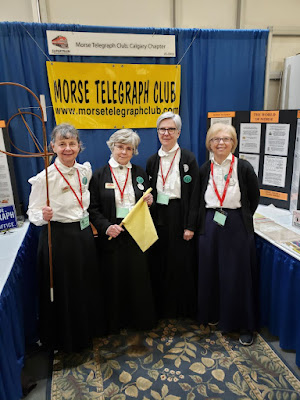The Day the Power Failed by Stuart Davis
From the now defunct Telegraph Lore site.
Available on the Wayback Machine here:
https://web.archive.org/web/20200218063219/http://www.telegraphlore.com/telegraph_tales/power_fail.html
The Day The Power Failed
{From the December, 1978 issue of The Telegrapher, published by the late
Dr.
E. Stuart Davis at his National Telegraph Office in Union, N.J. Thanks
to Bill Dunbar for providing this for use in Telegraph Lore.]
 |
A similar office in 1945
|
It was 10 o'clock on a typical 1924 Thursday morning rush hour in the Postal
Telegraph office at 84 State Street, Boston, Mass. The model 13s of the
Morkrum mux sets to New York, Philadelphia and Chicago were pounding away,
while the iron horse xtrs were gobbling up the slips almost as fast as the
punchers could prepare them.
In the Morse department some 70 operators were moving the heavy file. The
duplexes to Ford Motor, Montreal and Portland were "doubled." At the
overflow that hit the traffic early in the morning, the clang and bang of
the Lamson slingshot (conveyor) could scarcely be detected in the overall din.
Suddenly...the lights went out! The motors on the mux ground to a halt and
the only sound in this big room was faint clicks from Morse relays on the
Test Board. People glanced at each other in utter amazement, laughed and
then relaxed while the Wire Chiefs were pounding away on the Bell wires to
New York and Albany. "We lost our power!"
Meanwhile, Yours Truly was on his way to the power room in the basement.
What a sight! A huge 1,800 ampere fuse had blown, taking with it a section
of the marble switchboard and setting the connecting wires on fire. The
basement was filled with the acrid fumes of burning insulation and it was
obvious that power could not be restored for a long time.
Back on the fourth floor, Plant and T&R; men were arranging 200-ohm local
sounders so that they could be used as main line instruments. KOB sets were
brought and plugged into table jacks and one by one, lines that could be
powered from distant terminals were coming back into service. As quickly as
a circuit was made good, an operator was hard at work moving the delayed file.
Twelve single-Morse circuits were set up to New York, two to Chicago, and
one each to Detroit and Buffalo. Anybody and everybody who could telegraph
was pressed into service - including the Superintendent and Assistant
Sup't. A hurry call was put out for the extra force - and to the retirees.
By noon, more than a hundred operators were on duty.
At several desks, typewriters had been removed and pens and ink wells
brought out. Now, the 80 year-old bonus men of a bygone era were turning
out beautiful copy at 25-30 words per minute, such as only the artists of
the turn of the century learned to do. By 1 p.m. all delays had been
eliminated and traffic was flowing smoothly.
Uppermost in the mind of the Chief Operator was the question, "What shall I
do about the night file?" On Thursdays, the average was about 7,000
messages plus an unpredictable amount of overflow press that was copied in
the main office instead of the newspapers on Washington Street. The chief
was concerned for the welfare of the elderly operators who'd responded to
the emergency call and had been on duty since midmorning. Should they be
kept on overtime, it was decided to pack several thousand "Reds" (Night
Letters) into a leather bag which was then taken to South Station and
placed in charge of an Express Messenger. New York was given the train
number and made arrangements for it to be met at Grand Central Station. A
similar course of action was followed for the traffic that moved via
Chicago - except that a DCM was given a Pullman ticket aboard the "Wolverine," due in CH at 9 a.m.
As suddenly as it had been lost, power was restored, soon after 4 p.m. A
great cheer went up! Now the mux operators who had been demoted to the only
tasks they could perform around an all-Morse office - that of "check
clerks" - were back in business, and they made those old Perforators sound
like machine guns!
With normality restored there was a gathering of top brass in the T&R;
department. Each person had their own version of the day to relate. One
Wire Chief who wrote in a very tiny hand was asked, "How many words can you
put on a blank?" He didn't know, but replied, "I can copy a ten-word
message in the space of a postage stamp." Some bragged of how many words
they could stay behind the sender, and so it went.
Finally Wire Chief spoke up: "I'm not the fastest operator around here,
but I can copy a message in French with one hand and one in English with
the other at the same time."
The Chief Operator went out in the traffic department and returned with a
message from the Montreal Duplex in French, and one in English. The Wire
Chief was provided with pencils and pads. The two messages were sent at
usual hand key speeds. He made perfect copy of both! Amid cheers and slaps
on the back, the Superintendent sent out for hamburgers and near-beer
(Prohibition, you know) and the rest of us got back to work.
As the Old Timers told us young squirts, "We handled the business about as
fast as the machines, and we were a lot more reliable."















 He
practiced the profession of telegraphy in various capacities until the
key was replaced by teletype machines in 1933 on Associated Press
wires.
He
practiced the profession of telegraphy in various capacities until the
key was replaced by teletype machines in 1933 on Associated Press
wires.










